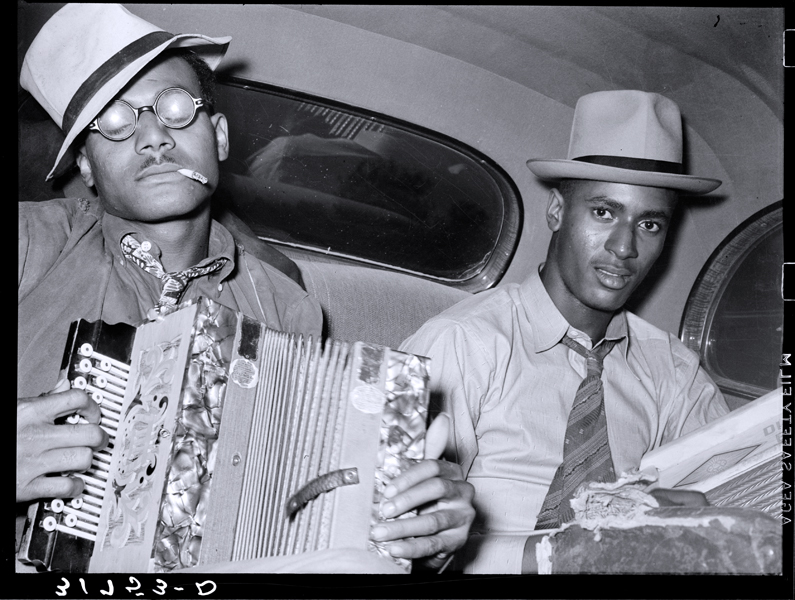Russell Lee
Nationally acclaimed photographer Russell Lee produced series of photographs on Louisiana life, including scenes of rural communities and New Orleans, for the Great Depression-era Farm Security Administration (FSA) project.

Courtesy of Library of Congress Prints and Photographs Division
"Negro musicians playing accordion and washboard in automobile. Near New Iberia, Louisiana.". Lee, Russell (photographer)
Within a year of taking his first photograph, Russell Lee landed a position as a photographer in the most important photographic survey in American history, the Farm Security Administration (FSA) documentary project, established by President Franklin Roosevelt’s administration to provide visual documentation of the Great Depression. From 1936 to 1942, Lee established his reputation as one of America’s finest documentary photographers with his FSA images.
Lee was born in Ottawa, Illinois, on July 21, 1903. He graduated from Lehigh University in Bethlehem, Pennsylvania, in 1925 with a degree in chemical engineering. A modest independent income allowed him to quit his profession a few years later when he decided to become a painter. In 1935, his career changed again after he picked up a camera as a means of improving his drawing skills. Almost by accident, he found his true vocation and devoted the rest of his life to photography.
Lee made photographs in thirty states for the government’s photo file, a collection that would grow to include 175,000 black-and-white film negatives and 1,600 film transparencies that are now housed in the Library of Congress. The goal of the FSA photographic project was to gain support for Roosevelt’s controversial New Deal programs by showing the need for them among the people hardest hit by the economic downturn in the 1930s and the Dust Bowl of the drought-stricken Midwest.
As Lee explained his job in the October 1941 edition of U.S. Camera magazine, “The idea is to show … what a Louisiana sharecropper looks like, what kind of house he lives in, how he works, what he wears, how he plays, and the problems he’s up against — so when a bill to aid sharecroppers is up before Congress and the Pennsylvania Senator supports the bill, the Pennsylvania voters will say, ‘Okey.’”
Lee spent a number of weeks during 1938 in Louisiana, where he made photographs in rural communities and New Orleans. Some of his most memorable pictures feature the National Rice Festival in Crowley, the Louisiana State Fair in Donaldsonville, All Saints Day in New Roads, and the riverfront in New Orleans. Lee liked to thoroughly document his subjects and frequently produced extended series of photographs on a common theme. In Louisiana he made series of photographs about river pilots and oyster and rice harvesting.
Lee is also known for his extended documentary series on Pie Town, New Mexico, made in 1940 with both black-and-white and color film, showing residents of the small community at work, at home, and at play. His images vividly illustrate Lee’s dedication to the goals of the FSA project, a goal FSA director Roy Stryker described as “introducing America to Americans.” As Lee explained it, his objective was to “show what the people of Pie Town—the old, the young, the diligent, the frivolous, and the careworn—were like; wherein they were just folks and wherein each was a unique individual. I had to show this in portraits and action shots that would speak of character.”
When the FSA was defunded in 1943, Lee photographed for the Air Transport Command during World War II. In 1947 he went back to work for Roy Stryker, who was now heading a massive documentary photography project for Standard Oil of New Jersey. His work for the Standard Oil Project led to other commissions for photographs from oil and steel companies. He never abandoned human subjects, however, and from 1949 until 1952 he produced a large photographic survey on the Spanish-speaking people of Texas.
In 1965, Lee began teaching the first classes in photography ever offered at the University of Texas. He died in Austin on August 28, 1986.
Lee’s photographs are housed within the collections of the Wittliff Gallery of Southwestern and Mexican Photography at Texas State University in San Marcos; the Briscoe Center for American History at the University of Texas in Austin; and the FSA Collection at the Library of Congress in Washington, D.C.
